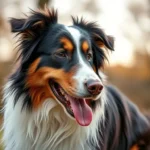
Introduction
Understanding dog breeds is essential for any prospective dog owner. Each breed comes with unique characteristics, traits, and histories that influence their behavior and suitability for various lifestyles. Among these breeds, the Bouvier des Flandres stands out due to its rich heritage and versatile nature. Originating from the Flanders region of Belgium, this breed has served as a working dog, herding livestock, and protecting property for centuries. In this article, we will delve into the fascinating world of the Bouvier des Flandres, exploring its history, physical traits, temperament, health considerations, and much more.
Understanding Dog Breeds
Dog breeds are distinct groups of dogs that share common characteristics, including physical traits, temperament, and behavioral tendencies. Understanding these characteristics is crucial for potential dog owners, as they can help determine which breed is the best fit for their lifestyle and family dynamics.
Definition of Dog Breeds
A dog breed is defined as a specific kind of dog that has been selectively bred for particular traits, whether for working, companionship, or show purposes. The Bouvier des Flandres is no exception; it was developed for herding and guard duties, showcasing the importance of purpose in breed development.
Importance of Breed Characteristics
Understanding the defining characteristics of a breed is vital for responsible dog ownership. Key aspects include:
- Physical Traits: Size, coat type, and color variations can greatly influence a dog’s care requirements and compatibility with owner lifestyles.
- Temperament: Different breeds exhibit various behavioral traits, impacting their suitability for families, singles, or elderly owners.
- Behavioral Tendencies: Understanding how a breed typically behaves can help in training and socialization.
Overview of How Breeds Are Categorized
Dog breeds are generally categorized by size, purpose, and other characteristics. The Bouvier des Flandres is classified as a working dog, known for its intelligence, strength, and versatility.
The Bouvier des Flandres: History and Origin
Historical Background
The Bouvier des Flandres has a storied history that dates back to the Middle Ages in the Flanders region of Belgium. Initially bred as a herding dog, it played a vital role in managing cattle and other livestock. Its name, which translates to “cowherd of Flanders,” reflects its agricultural roots.
Evolution of the Breed
The breed has evolved significantly over time. It is thought to have been influenced by several other breeds, including the Belgian Sheepdog and various mastiffs. During the World Wars, the Bouvier des Flandres also served as a military dog, showcasing its adaptability and loyalty.
Recognition by Kennel Clubs
The Bouvier des Flandres is recognized by several prominent kennel clubs, including the American Kennel Club (AKC) and the Fédération Cynologique Internationale (FCI). These affiliations help maintain breed standards and promote responsible breeding practices.
Physical Characteristics of the Bouvier des Flandres
Size and Weight
The Bouvier des Flandres is a robust and powerful breed. Males typically weigh between 90 to 110 pounds, while females generally range from 70 to 90 pounds. The average height for males is 25 to 27 inches, with females measuring 23 to 25 inches.
Coat and Color
The breed is known for its distinctive double coat, which is thick and somewhat harsh to the touch. Common color patterns include brindle, fawn, and black. The coat can be wavy or straight, requiring regular grooming to maintain its health and appearance.
Distinctive Features
The Bouvier des Flandres possesses several distinctive features:
- Build and Structure: The dog has a sturdy, muscular build, designed for strength and endurance.
- Facial Characteristics: A broad head, with a strong jaw and expressive eyes, gives the breed a noble appearance.
Temperament and Behavior
General Temperament Traits
The Bouvier des Flandres is known for its intelligence and loyalty. These dogs are often described as protective, making them excellent guardians for families and property. Their strong work ethic means they thrive on tasks and challenges.
Interaction with Families and Children
This breed is typically good with children, displaying patience and affection. However, early socialization is essential to ensure that they develop a well-rounded temperament. They are generally compatible with other pets but may exhibit territorial behavior if not properly trained.
Training and Socialization Needs
Training a Bouvier des Flandres requires consistency and patience. Early obedience training is crucial, as it helps to channel their intelligence and energy positively. Recommended training techniques include:
- Positive Reinforcement: Reward-based training methods work best for this breed.
- Socialization: Exposing the dog to various environments, people, and pets will help reduce anxiety and territorial behavior.
Health Considerations
Common Health Issues in the Breed
Like all breeds, the Bouvier des Flandres is prone to certain health issues. Common concerns include:
- Hip Dysplasia: A genetic condition affecting the hip joint, leading to arthritis and discomfort.
- Eye Conditions: The breed can be susceptible to conditions like cataracts and progressive retinal atrophy.
Lifespan and Aging Considerations
The average lifespan of a Bouvier des Flandres is around 10 to 12 years. As they age, regular veterinary check-ups become increasingly important to monitor for any health issues.
Importance of Regular Veterinary Care
Routine veterinary care is essential for maintaining the health of any dog, including the Bouvier des Flandres. Vaccinations, preventive measures, and regular check-ups can help catch health issues early.
Care and Maintenance
Dietary Needs
A balanced diet is crucial for the Bouvier des Flandres. High-quality dog food, either commercial or homemade, should be rich in proteins and nutrients. Always consult with a veterinarian for feeding recommendations tailored to your dog’s age, weight, and activity level.
Exercise Requirements
This breed requires significant daily exercise to stay healthy and happy. Aim for at least one to two hours of physical activity each day, which can include walks, playtime, and mental stimulation through training and games.
Grooming Routines
Regular grooming is necessary to maintain the Bouvier des Flandres‘ coat. Key grooming practices include:
- Brushing: Brush their coat at least once a week to prevent matting and remove loose fur.
- Bathing: Bathe as needed, usually every few months, unless they get particularly dirty.
Living with a Bouvier des Flandres
Ideal Living Conditions
The Bouvier des Flandres thrives in environments where it has space to move around. While they can adapt to apartment living, a house with a yard is preferable. They do well in both urban and rural settings, provided they receive adequate exercise.
Tips for First-Time Owners
Bringing a Bouvier des Flandres into your home can be a rewarding experience. Here are some tips for first-time owners:
- Prepare Your Home: Ensure your living space is dog-proofed, with no hazards or harmful substances within reach.
- Essential Supplies: Invest in quality dog food, a sturdy leash, a comfortable bed, and grooming tools.
- Patience and Training: Be prepared for the commitment required in training and socializing your new furry friend.
Conclusion
In summary, the Bouvier des Flandres is a remarkable breed that combines strength, intelligence, and loyalty. Understanding its history, characteristics, and care requirements is essential for anyone considering adding this noble dog to their family. With proper training, socialization, and care, a Bouvier des Flandres can be a loving and protective companion for many years. Always consider the unique traits of this breed when making your decision, ensuring a perfect match for your lifestyle and family needs.








